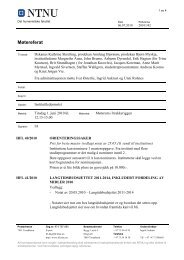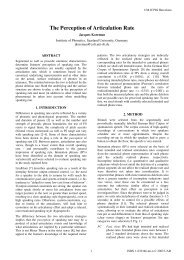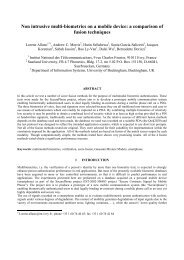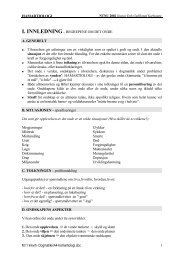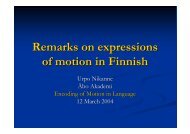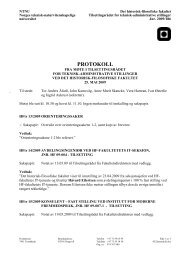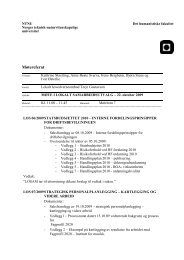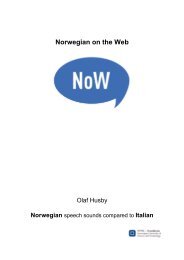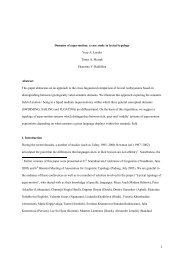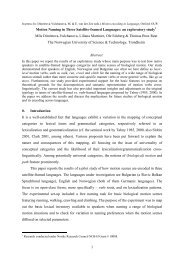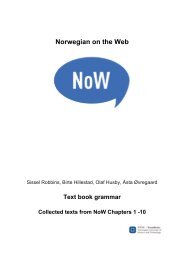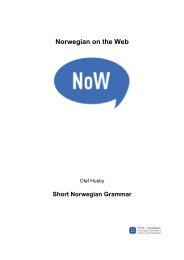Dutch Norwegian - NTNU
Dutch Norwegian - NTNU
Dutch Norwegian - NTNU
Create successful ePaper yourself
Turn your PDF publications into a flip-book with our unique Google optimized e-Paper software.
<strong>Norwegian</strong> on the Web<br />
Olaf Husby<br />
<strong>Norwegian</strong> speech sounds compared to <strong>Dutch</strong>
<strong>Norwegian</strong> on the Web, <strong>NTNU</strong> <strong>Dutch</strong>: p. 2 of 4<br />
<strong>Dutch</strong> and <strong>Norwegian</strong> speech sounds compared<br />
Below you will find a comparison between <strong>Norwegian</strong> (NO) and <strong>Dutch</strong> (NL) speech sounds, that is<br />
consonants, vowels and diphthongs.<br />
Consonants<br />
The column Consonant in the table below demonstrates <strong>Norwegian</strong> consonant sounds of Central<br />
East <strong>Norwegian</strong>. Column 2 and 3 show words of <strong>Norwegian</strong> (NO) and <strong>Dutch</strong> (NL) that sound similar<br />
or quite similar. The words may have different meanings. In these words the consonants in question<br />
are used. The degree of similarity is indicated by +, ~ or – in the column Overlap:<br />
+ The <strong>Norwegian</strong> consonant is quite similar to the <strong>Dutch</strong> one<br />
~ The <strong>Norwegian</strong> consonant is to a certain extent similar to the <strong>Dutch</strong> one<br />
– The <strong>Norwegian</strong> consonant has no counterpart in <strong>Dutch</strong><br />
<strong>Dutch</strong> consonants of the two first categories may be used when speaking <strong>Norwegian</strong>. Use of he<br />
second category implies stronger degree of foreign accent.<br />
Consonant <strong>Norwegian</strong> <strong>Dutch</strong> Overlap Comments<br />
/p/ penn pen + Unaspirated in NL<br />
/b/ båt boot +<br />
/t/ tal taal + Unaspirated in NL<br />
/d/ di die +<br />
/ʈ/ smart - –<br />
/ɖ/ ferdig - –<br />
/k/ katt kat + Unaspirated in NL<br />
/g/ goal goal – Only in loanwords in NL<br />
/m/ matt mat +<br />
/n/ nok nok +<br />
/ɳ/ barna - –<br />
/ŋ/ lang lang +<br />
/f/ faktor faktor +<br />
/ʋ/ voll wol +<br />
/s/ same samen +<br />
/ʃ/ sjal sjaal +<br />
/ç/ kjapp tjokvol –<br />
/j/ jeg jij +<br />
/h/ har haar +<br />
/r/ realist realist +<br />
/l/ låt lood + NO /l/ is not velarized (flat tongue in NO)<br />
/ɭ/ jarl - –<br />
Below you wil find the same data in a shorter version using colour codes:<br />
White:<br />
Grey:<br />
Black:<br />
The <strong>Norwegian</strong> consonant is quite close to the <strong>Dutch</strong> one<br />
The <strong>Norwegian</strong> consonant overlaps to some degree with the <strong>Dutch</strong> one<br />
The <strong>Norwegian</strong> consonant has no counterpart in <strong>Dutch</strong><br />
p b t d ʈ ɖ k g l ɭ r<br />
m n ɳ ŋ f ʋ s ʃ ç j h<br />
The speech sounds in black and grey cells are sounds that <strong>Dutch</strong>-speaking students should practice<br />
more in order to obtain a proper pronunciation of <strong>Norwegian</strong>.<br />
2
<strong>Norwegian</strong> on the Web, <strong>NTNU</strong> <strong>Dutch</strong>: p. 3 of 4<br />
Vowels<br />
The column Vowel in the table below demonstrates <strong>Norwegian</strong> vowel sounds of Central East<br />
<strong>Norwegian</strong>. Column 2 and 3 show words of <strong>Norwegian</strong> (NO) and <strong>Dutch</strong> (NL) that sound similar or<br />
quite similar. The words may have different meanings. In these words the vowels in question are<br />
used. The degree of similarity is indicated by +, ~ or – in the column Overlap:<br />
+ The <strong>Norwegian</strong> vowel is quite similar to the <strong>Dutch</strong> one<br />
~ The <strong>Norwegian</strong> vowel is to a certain extent similar to the <strong>Dutch</strong> one<br />
– The <strong>Norwegian</strong> vowel has no counterpart in <strong>Dutch</strong><br />
<strong>Dutch</strong> vowel of the two first categories may be used when speaking <strong>Norwegian</strong>. Use of he second<br />
category implies stronger degree of foreign accent.<br />
Vowel <strong>Norwegian</strong> <strong>Dutch</strong> Overlap Comments<br />
/i/ inn in +<br />
/iː/ rik riek +<br />
/y/ tylle tule ~ NL sound in between NO /y/ og /ʉ/<br />
/yː/ yr uur ~ NL sound in between NO /yː/ og /ʉː/<br />
/e/ penn pen +<br />
/eː/ lek leek +<br />
/ø/ løkke lukken +<br />
/øː/ løk leuk +<br />
/æ/ vært - –<br />
/æː/ lær - –<br />
/ɑ/ lapp lap +<br />
/ɑː/ mat maat +<br />
/ʉ/ tulle tule ~ NL sound in between NO /y/ og /ʉ/<br />
/ʉː/ ur uur ~ NL sound in between NO /yː/ og /ʉː/<br />
/u/ bukk boek +<br />
/uː/ bor boer +<br />
/o/ som som +<br />
/o:/ lån loon +<br />
In general the duration of <strong>Dutch</strong> vowels can be compared to short and long vowels in <strong>Norwegian</strong>.<br />
The table above is presented below in a shorter version using colour codes:<br />
White:<br />
Grey:<br />
Black:<br />
The <strong>Norwegian</strong> vowel is quite close to the <strong>Dutch</strong> one<br />
The <strong>Norwegian</strong> vowel overlaps to some degree with the <strong>Dutch</strong> one<br />
The <strong>Norwegian</strong> vowel has no counterpart in <strong>Dutch</strong><br />
i e æ ɑ y ʉ ø u o<br />
iː eː æː ɑː yː ʉː øː uː oː<br />
The sounds in black and grey cells are speech sounds that <strong>Dutch</strong>-speaking students should practice<br />
more in order to obtain a proper pronunciation of <strong>Norwegian</strong>. Observe that /æ/ and /ɑ/ are two<br />
different sounds in <strong>Norwegian</strong>. The <strong>Dutch</strong> /a/ is somewhere in between, maybe a little closer to<br />
<strong>Norwegian</strong> /ɑ/.<br />
3
<strong>Norwegian</strong> on the Web, <strong>NTNU</strong> <strong>Dutch</strong>: p. 4 of 4<br />
Diphthongs<br />
The column Diphthong in the table below demonstrates <strong>Norwegian</strong> diphthongs of Central East<br />
<strong>Norwegian</strong>. Column 2 and 3 show words of <strong>Norwegian</strong> (NO) and <strong>Dutch</strong> (NL) that sound similar or<br />
quite similar. The words may have different meanings. In these words the diphthongs in question are<br />
used. The degree of similarity is indicated by +, ~ or – in the column Overlap:<br />
+ The <strong>Norwegian</strong> diphthong is quite similar to the <strong>Dutch</strong> one<br />
~ The <strong>Norwegian</strong> diphthong is to a certain extent similar to the <strong>Dutch</strong> one<br />
– The <strong>Norwegian</strong> diphthong has no counterpart in <strong>Dutch</strong><br />
<strong>Dutch</strong> diphthongs of the two first categories may be used when speaking <strong>Norwegian</strong>. Use of he<br />
second category implies stronger degree of foreign accent.<br />
Diphthong <strong>Norwegian</strong> <strong>Dutch</strong> Overlap Comments<br />
/ɑi/ hai haai ~ NO /ɑ/ is somewhat shorter<br />
/æi/ reis reis +<br />
/øy/ høy - –<br />
/æʉ/ haus huis ~<br />
/oy/ koie nooit ~ NO /o/ is somewhat shorter than the NL<br />
/uy/ hoie roeit ~ Rare in NO<br />
/ʉy/ huie - – Rare in NO<br />
The table above is presented below in a shorter version using colour codes:<br />
White:<br />
Grey:<br />
Black:<br />
The <strong>Norwegian</strong> diphthong is quite close to the <strong>Dutch</strong> one<br />
The <strong>Norwegian</strong> diphthong overlaps to some degree with the <strong>Dutch</strong> one<br />
The <strong>Norwegian</strong> diphthong has no counterpart in <strong>Dutch</strong><br />
/ɑi/ /æi/ /øy/ /æʉ/ /oy/ /uy/ /ʉy/<br />
The sounds in black and grey cells are speech sounds that <strong>Dutch</strong>-speaking students should practice<br />
more in order to obtain a proper pronunciation of <strong>Norwegian</strong>.<br />
4



